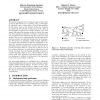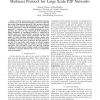13 search results - page 1 / 3 » Efficient atomic broadcast using deterministic merge |
PODC
2000
ACM
13 years 8 months ago
2000
ACM
We present an approach for merging message streams from producers distributed over a network, using a deterministic algorithm that is independent of any nondeterminism of the syst...
EUROCRYPT
2007
Springer
13 years 8 months ago
2007
Springer
Essentially all work studying the round complexity of secure computation assumes broadcast as an atomic primitive. Protocols constructed under this assumption tend to have very poo...
ASPLOS
2009
ACM
14 years 5 months ago
2009
ACM
Multicore hardware is making concurrent programs pervasive. Unfortunately, concurrent programs are prone to bugs. Among different types of concurrency bugs, atomicity violation bu...
DC
1999
13 years 4 months ago
1999
or fault-tolerant asynchronous systems. It abstracts a family of problems known as Agreement (or Coordination) problems. Any solution to consensus can serve as a basic building blo...
ICC
2007
IEEE
13 years 8 months ago
2007
IEEE
Overlay networks have shown tremendous potential in solving large scale data dissemination problem by employing peer-to-peer communication protocols. These networks, however, have ...


